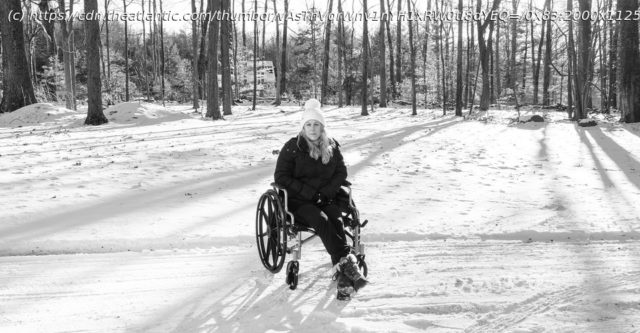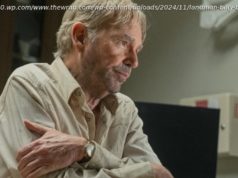Low-tech treatments are helping some patients—and revealing more about how the virus does its damage.
Photographs by Jonno Rattman The quest at Mount Sinai began with a mystery. During the first wave of the coronavirus pandemic in New York City, Zijian Chen, an endocrinologist, had been appointed medical director of the hospital’s new Center for Post-COVID Care, dedicated both to research and to helping recovering patients “transition from hospital to home,” as Mount Sinai put it. One day last spring, he turned to an online survey of COVID‑19 patients who were more than a month past their initial infection but still experiencing symptoms. Because COVID‑19 was thought to be a two-week respiratory illness, Chen anticipated that he would find only a small number of people who were still sick. That’s not what he saw. “I looked at the number of patients that were in the database and it was, I think,1,800 patients,” he told me. “I freaked out a little bit. Oh my God, there’s so many patients telling us that they still have symptoms.” A realization dawned on him: America was not simply struggling to contain a once-in-a-century pandemic, caused by a virus far more dangerous than seasonal influenza. Many patients were, for unknown reasons, not recovering. “We didn’t expect this from a virus,” he continued. “We expect that with viral infections as a whole, with few exceptions, you get better.” Many patients who spend significant time in an ICU—whether battling an infection or recovering from a stroke—do require further treatment even after they are released, because they suffer from something called post–intensive care syndrome, often characterized by weakness and cognitive problems. But that didn’t explain the group Chen was looking at. Startlingly, most had mild cases of COVID‑19—they had neither been hospitalized nor developed pneumonia. Before contracting the virus, many had no known health issues. Yet they were reporting significant ongoing symptoms—“shortness of breath, heart palpitations, chest pain, fatigue, and brain fog,” Chen told me. Chen quickly convened a multidisciplinary group of clinicians. The team began triaging patients with ongoing symptoms, referring them to specialists and teasing apart the causes. There were patients of all ages and backgrounds, with a wide array of problems, from persistent loss of taste and smell to chest pain. Some patients had been seriously ill, and they typically had the lung scarring, or fibrosis, that comes with COVID pneumonia; they were referred to pulmonologists for follow-up care. Others had readily observable heart problems, including myocarditis, an inflammation of the heart muscle, and were referred to cardiologists. Still others had blood clots. The extent of the damage COVID‑19 had done to them was highly unusual for a respiratory virus—and deeply alarming. But, Chen told me, “those were actually the luckier patients, because we could target treatment toward that.” The unlucky remainder—more than 90 percent of the patients the center has seen—was a puzzling group “where we couldn’t see what was wrong,” Chen said. These tended to be the patients who had originally had mild to moderate symptoms. They were overwhelmingly women, even though men are typically hit harder by acute COVID‑19. (Acute COVID‑19 refers to the distinct period of infection during which the immune system fights off the virus; the acute phase can range from mild to severe.) And they tended to be young, between the ages of 20 and 50—not an age group that, doctors had thought, suffered the worst effects of the disease. Most of the patients were white and relatively well-off, raising concern among clinicians that many people of color with ongoing symptoms were not getting the care they needed. These patients’ tests usually showed nothing obviously the matter with them. “Everything was coming back negative,” says Dayna McCarthy, a rehabilitation-medicine physician and a lead clinician at the center. “So of course Western medicine wants to say, ‘You’re fine.’ ” But the patients were self-evidently not fine. An international survey by Patient-Led Research for COVID‑19, one of various groups drawing attention to persisting problems, asked nearly 3,800 patients with ongoing illness to describe their symptoms. A significant number—85.9 percent—reported having relapses in the months after their initial infection, usually triggered by mental or physical exertion. (Not all patients in this group had confirmed cases of COVID‑19, given that tests were hard to come by last March and April.) Many patients were experiencing severe fatigue and brain fog. Other patients suffered from chest tightness and tachycardia—a condition in which the heart beats more than 100 times a minute—when they stood up or walked. Others had diarrhea and lost their appetite; some had terrible bone pain. Nearly a quarter said they were still unable to work; many had gone on disability or taken medical leave. Patient groups of COVID‑19 “long-haulers” were springing up on Facebook and elsewhere online, where people shared data and compared notes about what they began to call “long COVID.” One such patient, Caitlin Barber—who wound up at the Mount Sinai Center for Post-COVID Care this past fall—caught the virus in late March of last year at the nursing home where she worked as a dietitian. Barber, who is 28, was newly married and living in upstate New York. She ran half-marathons competitively; after work every day she went to the gym for two hours. Then she came home, made dinner for her husband, relaxed, and went to bed. “Everybody knows, that’s what I do every day,” she told me, speaking in the present tense. She paused. “I had a great life, a perfect life.” Barber’s case of COVID‑19 wasn’t bad. “It was kind of like a cold for me; I got very lucky in that respect.” Two weeks later, she went back to work. “Within three days, my world just crashed,” she said. She had difficulty writing simple reports. In the middle of a routine feeding-tube procedure—“Dietitian 101,” she told me—she found herself, tube in hand, unsure what to do next. She called her supervisor to take over. After a few such failed attempts to work, she went on medical leave. Perhaps 10 to 30 percent of those infected have long-term symptoms. “What people need to know is the pandemic’s toll is likely much higher than we are imagining.” Nearly a year later, Barber is mostly bedbound: “My symptoms change all the time. I’m happy if I can take a shower.” She struggles to brush her teeth or prepare meals, because her heart races to 180 beats a minute. (A typical rate is 60 to 100.) Convulsions sent her to the emergency room in September. She is alone most of the day—her husband works long hours—and she has to plan carefully in order to use the bathroom and feed herself without collapsing. There are chairs placed strategically throughout her apartment for her to rest on. Her friends ask her what she does all day at home. “I feel like I am very busy,” she told me drily. It can take her a whole day to wash her bedding, because of the spikes in her heart rate. Early on, many doctors, predictably, dismissed these cases as the result of anxiety or hypochondria. But at Mount Sinai, Chen and others tried to figure out what was happening. Their interest was not just academic. Beyond the terrifying impact on individual lives, the scope of the problem immediately alarmed them. “My goodness, the economic implications of this,” McCarthy told me. “You’re talking a huge number of 20-to-40-year-olds—our workforce—who now can’t work.” Today, informal estimates suggest that 10 to 30 percent of those infected with the novel coronavirus have long-term symptoms. “What people need to know is the pandemic’s toll is likely much higher than we are imagining,” Craig Spencer, the director of global health in emergency medicine at New York–Presbyterian/Columbia University Irving Medical Center, told me. “It is an area that merits urgent attention. There will be people living with the impact of COVID long after the pandemic is over. This is not made up or in the minds of people who are sickly. This is real.” And so, even as research scientists were developing the vaccines that will help bring an end to the acute phase of the pandemic later this year, the doctors at Mount Sinai and other academic medical centers began working to understand, and treat, the destruction that it is leaving behind. The unusual speed and scale of the effort are born of urgency. In many ways, the pace of progress has been remarkable, and innovations of a surprisingly low-tech sort are yielding results. But we still face a crisis of as-yet-unknown proportions that may change our medical system, our ideas about infectious disease—and the future of millions of Americans. Last April, the quest became the consuming focus of another group of Mount Sinai clinicians, known for its novel approaches to problems for which medicine doesn’t have easy answers. David Putrino is the director of rehabilitation innovation for the Mount Sinai Health System. Putrino spends his time on questions that many doctors don’t think about, including “measuring things that are hard to measure,” he told me. Before the pandemic, he was treating professional baseball and basketball players in his “high performance” clinic and doing TEDx Talks about the brain’s remarkable ability to heal itself. After the pandemic hit, with ICUs full and the hospital overtaxed, Putrino’s team built a platform to remotely monitor patients with suspected coronavirus infections who at other times might have been admitted to the hospital. This triage helped many sick patients stay out of the ER while Putrino’s team watched their oxygen levels. “And then my team started seeing these cases that weren’t getting better,” he told me. “My physical therapists were saying, ‘These symptoms are really different from those of acute COVID. We don’t know what to do with them.’ ” Related Stories How Science Beat the Virus Lyme Disease Is Baffling, Even to Experts When Putrino looked at the data, he saw the same symptoms that Chen saw. To Putrino, they looked like those of patients who suffer from a poorly understood and often misdiagnosed condition, one that he happens to know a lot about because his wife lives with it: dysautonomia, or impairment of the usual functioning of the autonomic nervous system, which controls blood pressure, temperature regulation, and digestion. Dysautonomia is itself an umbrella term for a host of different conditions, many of whose causes have yet to be fully pinned down. In common manifestations of it, a patient’s autonomic nervous system has trouble regulating the heart’s response to exertion, changes in posture, or variations in temperature, sending the body into an inappropriate fight-or-flight response. Some patients’ systems have trouble adjusting blood pressure or constricting blood vessels to send blood to the brain. Blood can pool in the legs and peripheries of the body; the heart might compensate by increasing its rate, while the body releases surges of adrenaline in a fruitless attempt to correct the problem. As a result, patients can experience some blend of fatigue, headaches, digestive problems, heart palpitations, difficulty breathing, and cognitive issues such as brain fog. By chance, Putrino had been working on a project for dysautonomia patients with Amy Kontorovich, a genetic cardiologist at Mount Sinai who studies the condition and has treated hundreds of patients with it. (After they met, Kontorovich ended up diagnosing and treating Putrino’s wife, who has Ehlers-Danlos syndrome, a group of genetic disorders that affect the body’s connective tissues; it is commonly associated with dysautonomia.) And so, as the team showed him the cases, Putrino told me, he felt a leap of recognition. “I looked at the symptoms and was like, ‘Oh my God.’ And I called Amy and said, ‘Help.’ ” Kontorovich was prepared for the call. A key clue had come her way: Two weeks earlier, she had received an email from a doctor she knew named Jessica Cohen, a 38-year-old who worked at a New York–area hospital. Cohen had tested positive for COVID‑19 on March 8—at the start of the first wave in New York—a few days after her husband returned from a trip to Scotland feeling logy. The couple have two young children. “I told him to ‘get over it,’ ” she says. “In retrospect, that may not have been the right thing to say.” At first her illness was relatively mild, like her husband’s. Tracking her oxygen levels and heart rate with her smartwatch, she felt she had gotten lucky. But on the eighth day—March 16—she went to the bathroom, and her heart began to race, beating more than 140 times per minute. Worried she had a blood clot, she texted a colleague, who told her to go to the ER. No one yet had any idea what COVID‑19 did to the heart. Cohen went to the Mount Sinai ER, where she was admitted so that doctors could observe her racing heart. But the tests that help identify risk of clots and heart attacks came back normal. The doctors couldn’t figure out what was wrong. They told Cohen they thought she just needed “some more time”; she might be weakened from a week in bed. Thinking that she needed to start pushing herself, she went home. That week, she forced herself to walk up the stairs in her house, only to collapse at the landing. She started having diarrhea and bouts of intense fatigue and severe headaches. One day she walked four blocks with her daughter to the store, where her heart began racing so fast that she had to sit down on the sidewalk until her husband came to pick them up. Cohen began posting in a doctors’ group on Facebook, eager to find out whether any of her colleagues had patients whose symptoms resembled hers. On the afternoon of March 26, she sat up in bed, and her heart rate skyrocketed. “I had an epiphany,” she told me. “I thought, Wait a second. Oh my God. This is like POTS”—postural orthostatic tachycardia syndrome, one of the subtypes of dysautonomia. She began sleuthing—and turned up a paper that suggested a connection between POTS and an inflammatory immune response common in cases of COVID‑19.






